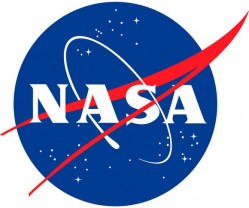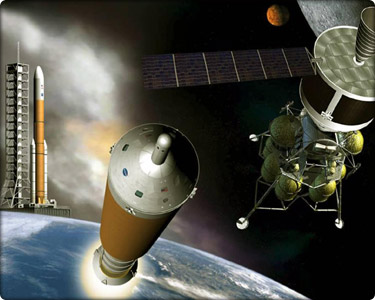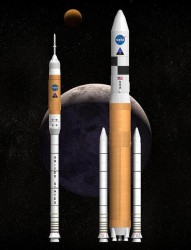C reative
Particle
Higgs
CPH Theory is based on Generalized light velocity from energy into mass.
CPH Theory in Journals
|
NASA’s Biggest Challenge? Congress
|
|
Written by Nancy Atkinson
Earlier this week, Orlando Sentinel columnist Mike Thomas wrote a scathing opinion piece on how NASA has been scamming the American taxpayers for decades, delivering very little for a whole lot of money. Additionally Thomas believes the Constellation program needs to be stopped to allow the concepts and technologies to be reviewed before more money is spent. The view from Thomas’ desk doesn’t seem to include a solution to any problems NASA may have, or any reasons why NASA might be in the predicament he proposes. So, how do others see NASA’s current situation, particularly someone who might have a closer view of what NASA is trying to accomplish? I recently had the chance to talk with Taber MacCallum, CEO of Paragon Space Development Corporation, a company working with NASA to help develop the Orion and Altair spacecraft. His opinion of NASA’s state of affairs is that the space agency is working as hard as it can and as best it can, given the constraints imposed by the US government.
“I think NASA has done an incredible job of getting
Constellation this far with the funding they’ve received,” he
said. “The more of us who have gotten into this program, the
more we have appreciated how much of the things we derogatorily
attribute to NASA are really things that Congress has created. I
think all Americans need to realize that when we say NASA has
problems, the problems are really with Congress. NASA has become
the organization it has in response to what Congress has made it
do.”
Taber MacCallum, CEO of Paragon Space It should be noted that MacCallum’s opinions are not in response to Thomas’ article, and they came unprompted during a generic interview a couple of weeks ago about Paragon, their work with the Constellation program and their recent partnership with Odyssey Moon in the Google Lunar X PRIZE.
Paragon is contracted by NASA to help develop the thermal control and life support systems for the Orion and Altair spacecraft, as well as doing preliminary work on a series of life support technologies for spacesuits for Mars. When asked about the challenges of helping to creating a new human spacecraft, MacCallum said that the biggest challenge for NASA is that Congress needs to fund the Constellation program at a level where it can be successful.
The Constellation Program. Credit: NASA Congress keeps putting NASA on continuing resolutions, but doesn’t have them on a funding profile that the program needs to be successful,” said MacCallum. “Its lots of money, yes, and you can’t equate Constellation to Apollo. Apollo was different because Congress and the Administration gave it a different agenda. NASA makes the smallest mistake now and it’s time for a congressional inquiry as to why all this taxpayer money is being wasted rather than saying that NASA is trying do something really hard and this time it didn’t work. Instead of an investigation we need to go try it again. We don’t seem to mind when a test pilot crashes a hundred million dollar aircraft into the ground. That’s part of developing high tech airplanes; that’s part of being on the cutting edge of defense. We accept all that. But when NASA plummets a spacecraft into the surface of Mars it’s time for a Congressional inquiry. It’s a whole lot harder to land a spacecraft on Mars than fly an airplane. But somehow, we treat this differently, and I haven’t figured out why that is, aside from congressmen trying to get brownie points.”
MacCallum said Americans need to see NASA’s mission with new eyes. “The paranoid, risk-averse, over-conservative appearance that we see NASA in currently is their response to Congress raking them over the coals repeatedly,” he said. “When you talk to people at NASA at an individual level they are so dedicated and really want to do the right thing. I think there are very few people just sitting on NASA’s laurels. For the most part these are people who want to see an aggressive space program and are working night and day to do it.” “The other real challenge we have is because we’ve put NASA in this sort of stand down mode for the past 30 years, we haven’t designed a new spacecraft. So there’s nobody around, literally, who has designed a manned spacecraft before,” MacCallum continued, “so all that experience from Mercury, Gemini, Apollo and the shuttle isn’t around. Even if they all were around, the tools are so radically different that we have to manage the technical side of these programs in a different way.”
The Ares rockets. Credit: NASA However, MacCallum said these are good challenges to have. “Gosh, we as a nation really need to learn how to do this. We have woefully under-challenged our youth, our people and our NASA. JPL does a great job, because every couple of years they crank out a new space mission. The planetary science people and companies like Lockheed have cranked out spacecraft regularly, so they have people who are used to that cycle; they’ve gone from concept to mission closeout. But a human spacecraft that goes in all the different environments from launch to on-orbit to around the moon to re-entry to landing, with all our of our human safety requirements, it’s a surprisingly new deal.”
So, what if the Constellation program were halted and NASA had no way to fly humans to space? “Soon we’re going to be at place, and people will wake up one day and realize we are in stand down mode and America can’t fly people to space, but only current and former communist countries can,” MacCallum said. “It’s going to be an interesting day. That gap is going to be pretty big. It terms of NASA’s charter to lead and Congress’s charter to give them what they need to lead, we’re in an interesting position where the most modern human spacecraft is made by China – not to demean the Chinese at all, but it’s not what we think of as American’s leadership in space. MacCallum said he will be interested in how the Obama administration deals with everything on NASA’s plate in addition to everything else currently facing the country. “They are clearly fighting lots of fires, and NASA has certainly been without an administrator longer than this before,” MacCallum said. “I think Obama realizes we need to be a leading country in science and technology. That’s our only chance to hold our own in the global economy. I was certainly inspired by space to take a career in science and be interested in engineering. I think a lot of kids are. We need to be doing interesting things that inspire kids and make them want to study math and science.”
Source: http://www.universetoday.com/2009/04/09/nasas-biggest-challenge-congress/
1 2 3 4 5 6 7 8 9 10 Newest articles
|
|
Sub quantum space and interactions from photon to fermions and bosons |
Interesting articles
Since 1962 I doubted on Newton's laws. I did not accept the infinitive speed and I found un-vivid the laws of gravity and time.
I learned the Einstein's Relativity, thus I found some answers for my questions. But, I had another doubt of Infinitive Mass-Energy. And I wanted to know why light has stable speed?




